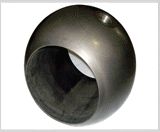

current position:Information and data>The difference between spray welding
The difference between spray welding
The combination of spray coating and spray welding layer with the base metal is different. The nickel-clad aluminum undergoes an exothermic chemical reaction when heated by the spray flame beam, and the surface of carbon steel with RZ>50μm forms a micro-metallurgical bond after sandblasting and derusting to Sa3 level. The bottom layer and the working layer produce a mechanical bonding coating with "anchor hook" effect, while the combination of the spray welding layer and the substrate is purely a metallurgical bonding coating.

The denseness of the coating is different, the spray-welded layer is dense, but there are a small amount of pores in the sprayed layer. The ability to withstand loads is different. The spray coating can generally withstand large-area contact. It is mostly used on working surfaces with lubrication conditions, mating surfaces and other working conditions with less stress, but the spray welding layer can withstand greater impact. , Extrusion stress or contact stress, etc.
The spraying materials are different, spray welding requires the use of self-fluxing alloy powder, while spraying does not require high self-fusion of the powder, and it is not necessarily self-fluxing alloy powder.Various self-fluxing alloy powders can be used for both spray welding and It can be used for spraying, but the sprayed powder does not have self-fluxing properties and can only be used for spraying and not for spray welding. The heating of the workpiece is different. During spraying and spray welding, the preheating temperature before spraying is different, the workpiece is affected by heat differently, and the structure and performance of the workpiece after spraying are also different.
Hot information

